
Biennial Report 2014-2015
Education Programs
The education and training of the next generation of atmospheric and marine scientists is an essential aspect of the SoMAS mission. Additionally, graduate and undergraduate students play a critical role in the cutting-edge research conducted at the School. Students at SoMAS have the opportunity to get to know and work closely with world-class faculty, take field courses, and conduct research in a wide range of coastal and oceanic environments. SoMAS offers classes at the Stony Brook and Southampton campuses where students have access to world-class facilities well-equipped to support research and education in a wide variety of oceanographic and atmospheric disciplines. The following are the undergraduate and graduate degree programs offered at SoMAS, and their present enrollments.
Undergraduate Degrees
Enrolled in Undergraduate Degrees, 2014
Enrolled in Undergraduate Degrees, 2015
B.S. in Atmospheric and Oceanic Sciences, 2014
B.S. in Atmospheric and Oceanic Sciences, 2015
B.S. in Atmospheric and Oceanic Sciences
The Atmospheric and Oceanic Sciences (AOS) program is structured to meet the educational needs of students wishing to pursue meteorology-related careers. The School’s location allows for detailed study of coastal weather phenomena, such as hurricanes, nor-easters, and sea-breezes, as well as regional climate change in a coastal-urban environment. AOS majors are prepared for a range of career options including weather forecasting, environmental meteorology, broadcast meteorology, and graduate school in atmospheric sciences. The Bachelor’s degree meets the requirements for employment as a meteorologist with the National Weather Service and private companies, and the curriculum also satisfies the education standards endorsed by the American Meteorological Society. With strong background training in physics, mathematics and computer science, our AOS majors are also well prepared for a variety of alternative career paths.
B.S. in Marine Sciences, 2014
Minor in Marine Sciences, 2014
B.S. in Marine Sciences, 2015
Minor in Marine Sciences, 2015
Marine Sciences is a highly interdisciplinary field requiring an understanding and application of basic science, including biology, physics, and chemistry. In particular, the Marine Sciences major provides students with a solid background in basic biology as well as in the physics and chemistry of the ocean. Upper-division electives permit each student to gain a deeper understanding of particular groups of organisms (microorganisms, algae, marine invertebrates, fish, and marine mammals) and of habitats (salt marshes, rocky inter tidal, barrier islands, dunes, estuaries, and the open ocean).
A Minor in Marine Sciences is also available.
B.S./M.S in Marine Science Combined Degree Program, 2014
B.S./M.S in Marine Science Combined Degree Program, 2015
B.S./M.S in Marine Science Combined Degree Program
Outstanding students in the Marine Sciences B.S. program can be considered for a combined B.S./M.S. program allowing them to begin coursework and research towards an M.S. in Marine and Atmospheric Sciences while still an undergraduate. This accelerated program would allow students to complete both degrees in as little as five years of full-time study. Students will normally be considered for admission into the combined degree program after completing their junior year of undergraduate study — either before the start or during their senior year. Students with exceptional records may be admitted during their junior year. Students who transfer to Stony Brook after their junior year must complete one semester at Stony Brook before they will be considered for admission to this combined BS/MS program. Students considering this program must identify a SoMAS faculty member willing to serve as their MS thesis advisor.
B.S. in Marine Vertebrate Biology, 2014
B.S. in Marine Vertebrate Biology, 2015
B.S. in Marine Vertebrate Biology
The Marine Vertebrate Biology major provides students with a solid background in basic biology with an emphasis on marine vertebrate organisms such as fish, sharks, birds, turtles and marine mammals. It provides a more intensive zoology background than the Marine Sciences degree.
B.A. in Environmental Studies, 2014
B.A. in Environmental Studies, 2015
The Environmental Studies major, leading to a Bachelor of Arts degree, is designed to provide students with the analytical and communication skills and the broad background necessary to understand and address complex environmental issues. The major also offers the opportunity for students to carry out focused study within a specific area of interest. Environmental issues are not resolved in the scientific, technological, social or political arenas alone. The curriculum is, therefore, interdisciplinary and integrates principles and methodologies from the social sciences, engineering, the natural sciences and humanities. The goal is to address the complex scientific, legal, political, socioeconomic and ethical issues that define and surround environmental issues. A minor in Environmental Studies is also available (2014: 16 enrolled, 2015: 18 enrolled).

The Semester-by-the-Sea program is designed for Stony Brook and visiting undergraduate students to spend a semester immersed in marine studies at the Stony Brook Southampton campus. The fall program uses an experiential learning approach, taking full advantage of the Southampton Marine Science Center, its research vessels, its waterfront marine lab facilities, and the unique campus location on the shores of Shinnecock Bay for direct access to marine and coastal field sites. Students explore the diverse marine habitats of eastern Long Island including estuaries, shallow bays, salt marshes, rocky intertidal, dunes, beaches, tidal flats, and the Atlantic Ocean, and examine current environmental issues related to these habitats. They are also introduced to the historic and contemporary maritime traditions of Southampton, Long Island, New York, and New England through classes and focused field trips to sites that have shaped these traditions. Students can also participate, or continue their studies, in the spring program which offers additional marine science and environmental courses.
Graduate Degrees
Enrolled in Graduate Degrees, 2014
Enrolled in Graduate Degrees, 2015
M.A. in Marine Conservation and Policy, 2014
M.A. in Marine Conservation and Policy, 2015
M.A. in Marine Conservation and Policy
Established in 2010, the Masters of Arts Degree in Marine Conservation and Policy provides students with an understanding of contemporary marine conservation and policy issues. It equips students with the skills necessary to apply this knowledge in marine conservation positions that require advanced training and a broad skill-set, but are not research-based. Graduates of this program should compete effectively for positions in government, environmental consultancy, and non-governmental organizations, and to apply marine conservation and policy knowledge in other fields such as law, teaching, communications or business.
M.S. in Marine or Atmospheric Sciences, 2014
M.S. in Marine or Atmospheric Sciences, 2015
M.S. in Marine or Atmospheric Sciences
The Masters of Science Degree at SoMAS features separate tracks in the marine and the atmospheric sciences.
The M.S. program, marine sciences track, consists of a rigorous interdisciplinary approach to oceanographic processes. The program is ideally suited to prepare students for positions in research, management, environmental protection and resource development. Graduates will have a firm basis for more advanced study and the tools and training needed for effective careers.
The M.S. program, atmospheric sciences track, provides students a rigorous training in atmospheric physics, thermodynamics, dynamics, radiative transfer, and their application in weather forecasting, satellite and conventional atmospheric data analysis, numerical modeling and climate change. Students gain strong communication, analytical and computer skills for positions in research, education, management and environmental protection.
Ph.D. in Marine or Atmospheric Sciences, 2014
Ph.D. in Marine or Atmospheric Sciences, 2015
Ph.D. in Marine or Atmospheric Sciences
The Ph.D. program at SoMAS prepares students to identify and solve problems in the oceanographic and/or the atmospheric sciences. It builds on a flexible, interdisciplinary program and trains students to become effective, independent thinkers and problem-solvers. Students are free to emphasize their own interests in oceanography and/or the atmospheric sciences, but are expected to acquire a broad base of interdisciplinary knowledge. Ph.D. graduates are prepared to compete successfully for postdoctoral and faculty appointments as well as for positions directing research at government or industrial laboratories, and managerial positions at not-for-profit and government agencies.
Alumni
One of SoMAS’s paramount objectives is to educate and train students to become the next generation of marine and atmospheric scientists, environmental resource managers, and citizens who possess a fundamental grasp of environmental issues and the choices that society faces in handling these issues. The alumni of our undergraduate and graduate education programs thus represent perhaps most important of the School’s “products,” extending the influence and impact of SoMAS on the broader society of which it is a part. Of all the things we produce, our alumni are inarguably the most valuable and have the most impact on the issues and problems that command the School’s attention. SoMAS alums occupy a dizzying variety of positions within academia, natural resource management agencies at all levels, and in the offices of non-governmental organizations. Alumni are often in a position to play a critical role in support of various SoMAS research and educational efforts. Several SoMAS alumni are represented on the Dean’s Council, a small assembly of influential individuals who advise the Dean on overall program development priorities and help to get initiatives underway. Several years ago, SoMAS began a concerted effort to strengthen connections with its alumni. Working with the Stony Brook University Alumni Association, our alumni records have been consolidated so that our communications with alumni are more comprehensive, reliable and, ultimately, effective.
MSRC/SoMAS produced its first masters degree graduates in 1971 and, a decade later, its first Ph.D. recipients. Through the years, 911 students have joined the ranks of SoMAS alumni, 266 with the Ph.D. and 715 with a masters degree, and 72 students received both degrees. As of December 2015, a total of 611 students have graduated with an undergraduate degree from SoMAS. Of these, 264 received the Environmental Studies degree, 59 the Atmospheric Sciences degree, 120 the Marine Sciences degree and 168 the Marine Vertebrate biology degree.
To each of our alumni, there is a story. Alumni below were highlighted between 2014 and 2015.
Emily Markowitz (BS, 2015)
 In the Fall of 2015, Emily Markowitz was a senior graduating with a major Marine Sciences with minors in Coastal Environmental Science, Geospatial Science and Theatre. She was accepted into the Accelerated BS/MS degree program with Dr. Janet Nye in her Fisheries Ecology Lab. Emily is very excited to start doing real, meaningful research and contribute to the scientific community.
In the Fall of 2015, Emily Markowitz was a senior graduating with a major Marine Sciences with minors in Coastal Environmental Science, Geospatial Science and Theatre. She was accepted into the Accelerated BS/MS degree program with Dr. Janet Nye in her Fisheries Ecology Lab. Emily is very excited to start doing real, meaningful research and contribute to the scientific community.
Emily had a variety of experiences during her time at Stony Brook. She received the Stony Brook Mote Marine Lab Scholarship during the summer of 2015 and spent 10 weeks doing research in a snook release project at the Laboratory’s Aquaculture Park in Sarasota, Florida. She served as the president of the Stony Brook Undergraduate Marine Science Club for two years, and lead the group on activities that included trawling and whale watching trips out of Southampton, seal walks, and volunteering with various organizations such as Coastal Steward and Cornell Cooperative Extension’s Marine Meadow Restoration Program. These organizations have also been included at events like Earthstock. The club also participated in the Pew Charitable Trusts’ Bluefin Tuna Initiative and won a trip to meet with Pew and the head of NOAA fisheries, Sam Raunch, to talk about the Pew initiative. The club continues to provide our community with talks and public screenings of documentaries. For many of the students in the club, these events are their introduction to research and conservation issues in Marine Science. In 2014, Emily also headed a major outreach program in which Marine Science Club members gave presentations (with valuable assistance from Dr. Larry Swanson) to two local middle schools about marine pollution and how it affects Long Island’s local biodiversity.
Emily’s experiences as a crew member on the R/V Seawolf, including trips to assist the New Jersey DEP in doing trawls and collecting data for their quarterly stock assessment program allowed her to see, first-hand, the distribution and density of our coastal waters and how a program like this works.
Emily’s undergraduate research experiences have allowed her in a number of labs on campus, including those of Drs. Janet Nye, Brad Peterson, and Joe Warren. While each lab pursued different questions and had different approaches and specialties, each experience provided her with greater insight into laboratory structure and methodology. While studying abroad in New Zealand, she also worked for Dr. Steven Wing in his lab. Wing is exploring isotope markers in fish populations.
Everything that Emily learned at Stony Brook and all of the extracurricular activities she participated in made her a better candidate for the BS/MS accelerated program and better prepared to write her thesis and, she hopes, “to pursue my Ph.D”.
Emily encourages students to join a club and meet people and get involved with the programs and organizations that are around campus and off campus! She says “that’s how you make opportunities, and build your experience! The way I got my first opportunity in a lab was by asking. Seek out professors and find out what they’re doing. Pick out what interests you and offer your services. Learn to code! Take classes in R or Matlab and learn ArcGIS. These programs make it possible to do the analysis that makes research relevant.”
Tyler Abruzzo (MS, 2015)
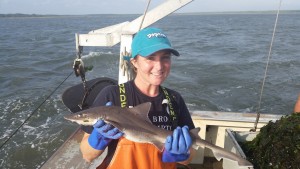 In 2015, Tyler Rose Abruzzo became the first student to graduate from the combined BS and MS program at SoMAS, a program designed to allow high achieving undergraduates to use up to 12 credits of course work towards both their undergraduate and graduate degrees. For her Master’s thesis, Tyler studied the temporal and spatial dynamics of the finfish and macro-invertebrate community in the Peconic Bay Estuary under the joint direction of Professors Dr. Robert Cerrato and Dr. Michael Frisk. She was also involved in sampling finfish, macro-invertebrates and sediment in the Great South Bay and Mill Neck Creek. According to Tyler, “My experiences and field work at SoMAS have been not only knowledgeable but fun and unforgettable. My professors and peers have left a lasting impression on me.”
In 2015, Tyler Rose Abruzzo became the first student to graduate from the combined BS and MS program at SoMAS, a program designed to allow high achieving undergraduates to use up to 12 credits of course work towards both their undergraduate and graduate degrees. For her Master’s thesis, Tyler studied the temporal and spatial dynamics of the finfish and macro-invertebrate community in the Peconic Bay Estuary under the joint direction of Professors Dr. Robert Cerrato and Dr. Michael Frisk. She was also involved in sampling finfish, macro-invertebrates and sediment in the Great South Bay and Mill Neck Creek. According to Tyler, “My experiences and field work at SoMAS have been not only knowledgeable but fun and unforgettable. My professors and peers have left a lasting impression on me.”
Tyler went directly from graduating at Stony Brook to her new position as a Staff Scientist at H2M Architects & Engineers, where she will be working on delineating wetlands throughout Long Island for construction projects as a consultant. She will also be acquiring environmental permits for clients for proposed construction work, as well as working with Townships for project approval. According to Tyler, “my degree at Stony Brook gave me a broad background in general ecology, therefore I was able to find a company that will help start my career as a biological environmental consultant.”
Her advice to other students is to take advantage of the integrated BS/MS program at SoMAS and to take classes that might be outside your comfort zone to gain knowledge on other subjects. She says “You’ll never know what type of experience/knowledge an employer might be looking for. Therefore, the more knowledge you have about different subjects and the more field techniques you learn will better your chances of landing a job. She describes the experience of the BS and MS program as being ”…a smooth transition from being an undergraduate to a graduate. I knew most of the faculty and their research at SoMAS from my undergraduate classes which made finding an adviser who would support the type of research I wanted to do for my Masters much easier.”
Christopher Martinez (PhD, 2014)
Christopher Martinez may be a marine biologist from California, but he didn’t grow up near the ocean. Visalia, his hometown, is a small farming city in the San Joaquin Valley. His family of migrant workers traveled the West picking crops. “Because of their hard work, I was able to pursue my dream,” said Christopher, who earned his PhD in 2014.
That dream was to study biology. Animals and insects always interested Christopher, but when he made the three-and-half-hour trip to the ocean, “I was fascinated by the diversity of ocean life.”
As an undergraduate at the University of California at Santa Barbara, his passion for marine sciences solidified. Christopher became research diver certified and was listed as co-author of a study, published in 2011 in Marine Biology, for his research in French Polynesia.
When Christopher applied to the graduate program at Stony Brook, the School of Marine and Atmospheric Sciences (SoMAS) awarded him a Turner Fellowship.
The W. Burghardt Turner Fellowship helps qualified underrepresented graduate students seeking certain degrees. Since 1987, the Fellowship has graduated more than 400 degree recipients.
The Center for Inclusive Education (CIE), which provides Turner Fellowship funding, became Christopher’s second home. “The CIE offered me a support system and a sense of family,” he said. After losing outside funding, the CIE helped Christopher pay for flounder movement pattern research in Long Island bays.
Michael Frisk, associate professor in SoMAS and Christopher’s PhD advisor, helped him redirect his research. “Mike told me to design a project that truly reflected my academic interests,” said Christopher.
After studying geometric morphometrics with Distinguished Professor emeritus F. James Rohlf, Christopher pursued ecological morphology of skates and rays and spatial modeling of marine communities in the Northwest Atlantic with a grant Frisk helped him secure.
“Chris was a very bright, dedicated student,” said Frisk. “He read the literature across disciplines and developed and applied modeling methods to quantify fish communities.”
These skills helped Christopher develop his postdoctoral research proposal and earn dual fellowships with the American Museum of Natural History, where he will take advantage of the Museum’s very large fish collection.
Christopher credits much of his success to Stony Brook. “The overall level of research among faculty and graduate students at Stony Brook is really impressive,” said Christopher. “I’ve had many opportunities at Stony Brook because of its proximity to New York City, specifically the Museum of Natural History.”
Kenneth Lang (MA, 2013)
Former Marine Conservation and Policy Masters student Kenneth Lang (fall 2013) was recently selected for the prestigious John A. Knauss Marine Policy Fellowship. The competitive fellowship recruits students from 33 Sea Grant programs nationwide to complete a one year paid fellowship in either the legislative or executive branch of the U.S. government in Washington D.C. Ken’s placement in the program is with NOAA’s International Affairs Office where he will focus on research in Europe, Russia, and the Arctic beginning in February.
While in Stony Brook’s Marine Conservation and Policy program, Lang completed an internship with the United Nations Development Programme (UNDP) and the Global Environment Facility (GEF) International Waters Programme, where he studied three dozen transboundary water environmental remediation projects. Lang felt that his Knauss placement was a perfect fit with the skills and knowledge he obtained during his time in the MCP program.
“My internship taught me a great deal, and the MCP program was the perfect leader into the Knauss fellowship,” said Lang. “You get experience in both science and policy in the MCP program.”
The Knauss Fellowship, which started nearly 30 years ago, provides an excellent opportunity for students interested in Marine Policy to kickstart their careers and obtain relevant, high-level experience in the nation’s capital. According to Professor Anne McElroy, former director of NY Sea Grant and current Graduate Program Director as SoMAS, “there is no better opportunity than the Knauss Fellowship for getting first-hand experience in how policy is made or establishing a professional network within the environmental management community.”
Lang, whose 2014 class includes the 1000th fellow to enter the program, has this advice to other MCP students aiming to follow his lead: “Graduate students hold a privileged status in society. Use that status,” says Lang, “You get where you want to go by talking to other people.”
Owen Doherty (PhD, 2012)
Owen Doherty earned his PhD from Stony Brook in December 2012, working on mineral dust transport. He, Nicole Riemer, Sultan Hameed and Kirk Cochran successfully identified a new paradigm that explained variability and loadings and sources of mineral dust blowing off Africa. He then went on to post-doc at Scripps Institution of Oceanography in San Diego. According to Owen, “life as an academic post-doc is sort of the pinnacle. You get to spend almost all of your time deep into a research project, learning new things and exploring your ideas in depth.”
In addition to conducting research while at SoMAS Owen helped teach a number of courses on a wide range of topics including global environmental problems, thermodynamics, remote sensing, MATLAB and data analysis. “Kirk Cochran and Anne McElroy taught me how to develop, manage and teach a large overview course. I owe them a lot for showing me the ropes.” He also developed leadership skills at Stony Brook “as head of Friday Beers, to head of the softball team and ultimately president of the grad club and a member of the Dean search committee.”
Owen’s data analysis background and leadership skills have continued to serve him well. He recently started up a consulting firm called Eagle Rock Analytics. He admits that starting your own business is “both daunting and exciting.” He gets to incorporate his wide range of skills to brainstorms new project ideas, collaborate with others, do science and data analysis every day. “The future of science is multidisciplinary studies, so folks who have a wide breath of knowledge to work from are at an advantage.”
Owen’s advice for students at SoMAS are entrepreneurial in spirit as he puts the onus on individuals to guide their own learning, rather than always relying on professors to lead the way. “Taking courses in grad school is like riding a bike with training wheels — take off the training wheels, read a paper, set up an experiment and teach yourself!”
Cassie Bauer (MS, 2012)
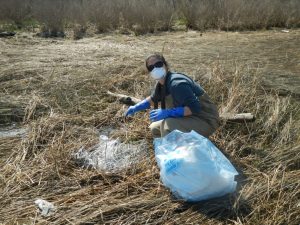 Cassie Bauer received her BS and MS from SoMAS in 2009 and 2012 respectively. Her thesis research involved the physical processes that contribute to localized, seasonal hypoxic conditions in the bottom waters of Smithtown Bay, Long Island Sound.
Cassie Bauer received her BS and MS from SoMAS in 2009 and 2012 respectively. Her thesis research involved the physical processes that contribute to localized, seasonal hypoxic conditions in the bottom waters of Smithtown Bay, Long Island Sound.
According to Cassie, “My thesis work gave me experience doing research in the Sound, understanding the Sound’s water quality issues, and developing relationships with researchers and environmental groups. This directly prepared me for a job as the Long Island Sound Study Coordinator”
Cassie works with the New York Department of Environmental Conservation as the Long Island Sound Study Coordinator. This is a bi-state partnership to restore and protect the Long Island Sound where her job responsibilities include co-chairing technical work groups, attending meetings, managing grants, collecting data on environmental indicators, tracking state activities, and writing reports, newsletters, and management plans. According to Cassie, “I also get to interact with many local environmental organizations and help out with various educational and outreach events, which I think is the most exciting aspect of my job.”
Her advice to incoming and current students is to “take advantage of the knowledgeable and friendly faculty and staff and the excellent resources SoMAS has to offer.”
Christopher Lang (MA, 2012)
Christopher Lang, a graduate of the Marine Conservation and Policy (MCP) Master’s Program, is using his degree to make a difference in environmental policy.
Lang, who graduated from the MCP program in 2012, works as a Legislative Fellow in the New York Senate. The prestigious Legislative Fellowship Program, which accepts graduate students from a variety of programs, pairs students with New York Senators to do legislative research and write policy. Lang is working with Senator Catharine Young whose work in agriculture and environmental policy is a good match for Lang’s interests and abilities.
Lang hopes to focus on aquaculture policy during his time in the New York Senate, and attributes much of his professional success to the MCP program and to the courses he took during his time at Stony Brook University.
“I definitely wouldn’t be in a position to get this job without the MCP program,” says Lang.
The MCP program allows students to tailor their degree, offering courses in environmental law and policy, science communication, and other more traditional science-based conservation classes. After students complete their coursework, they complete a capstone project or internship, where they apply the skills developed in classes to real-life scenarios in the workplace. Lang chose to participate in an internship with the Mystic Aquarium as an educator, a position that gave him some extra experience in communication. “I never dreamed this was where it would take me. Use the diversity of the program to your advantage,” Lang advises current and prospective students.
Lang certainly has done that. Having received a Bachelor’s degree in Biology from Providence College, he took Environmental Law classes as an MCP student, which helped him understand and become familiar with court and law documents. However, Lang believes the science communication courses were the most beneficial for him.
“Those courses can prepare you for anything. I had a lot of fun in my improvisation course, and learned so much as well,” states Lang.
Looking forward, Lang plans to use the connections and skills he gains as a Legislative Fellow to his advantage in future work with environmental policy, either in a state or federal agency or in a private firm.
Kelly Lombardo (PhD, 2011)
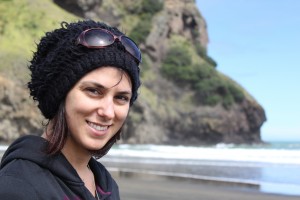 Kelly Lombardo, received her Ph.D. in 2011 from SoMAS working with Professor Brian Colle and is now an Assistant Professor at the University of Connecticut. At her current position, the job responsibilities that she enjoys most are teaching, developing new courses, and collaborating with her interdisciplinary department While a Ph.D. student at Stony Brook, Kelly studied the influence of the offshore marine atmospheric boundary layer on severe coastal storms and the processes that degrade or promote the survival of squall lines moving from coastal or inland regions to offshore regions. According to Kelly, SoMAS exposed her to “a wide range of course material, including atmospheric radiation, numerical modeling, synoptic and mesoscale meteorology, atmospheric dynamics, and physical oceanography.” She identifies one of the more essential tools she learned as a student “was the ability to multitask, a skill I use everyday as a professor.” Kelly would like to see every student as SoMAS “take advantage of every opportunity available even if it doesn’t immediately apply to your current research or career path. There is a good chance that the experiences and knowledge you gain will help you in future endeavors you haven’t anticipated.”
Kelly Lombardo, received her Ph.D. in 2011 from SoMAS working with Professor Brian Colle and is now an Assistant Professor at the University of Connecticut. At her current position, the job responsibilities that she enjoys most are teaching, developing new courses, and collaborating with her interdisciplinary department While a Ph.D. student at Stony Brook, Kelly studied the influence of the offshore marine atmospheric boundary layer on severe coastal storms and the processes that degrade or promote the survival of squall lines moving from coastal or inland regions to offshore regions. According to Kelly, SoMAS exposed her to “a wide range of course material, including atmospheric radiation, numerical modeling, synoptic and mesoscale meteorology, atmospheric dynamics, and physical oceanography.” She identifies one of the more essential tools she learned as a student “was the ability to multitask, a skill I use everyday as a professor.” Kelly would like to see every student as SoMAS “take advantage of every opportunity available even if it doesn’t immediately apply to your current research or career path. There is a good chance that the experiences and knowledge you gain will help you in future endeavors you haven’t anticipated.”
Hazel Wodehouse (MA, 2011)
Graduates from the Marine Conservation and Policy Program are prepared for a variety of careers, including jobs in the government, non-profit, and private sectors. One recent MCP graduate, Hazel Wodehouse, is training the next generation of ocean scientists at Suffolk Community College on Long Island.
Since graduating from the MCP program, Wodehouse has been teaching courses such as Environmental Issues and Introduction to Oceanography as an adjunct professor. Wodehouse finds that after taking her courses, her students have a deeper connection with the environment and the marine habitats that surround them. She described a particular experience about a year ago when she took students to see a whale necropsy.
“I took all of my classes to see the whale that day,” recalled Wodehouse. “One of my students told me later that seeing the whale was the highlight of their educational career.”
Wodehouse attributes the MCP program for helping her being successful in her career. Courses required by the program in communicating science were among her favorite, and got her interested in teaching. The one-year program allowed her to get a quality education in a short amount of time. What is her advice to the current class?
“Take advantage of as many opportunities as you can. Even if you don’t initially think you’ll be interested in something, you might surprise yourself,” says Wodehouse.
Kestrel Perez (PhD, 2011)
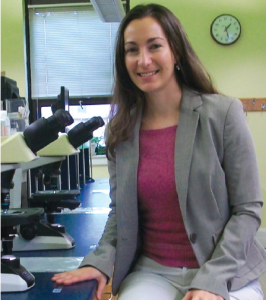 KESTREL PEREZ graduated in 2011 with her PhD in marine and atmospheric sciences. Under the advisement of Professor Stephan Munch, Kestrel’s dissertation examined the evolution of size in fish and evaluated the strength of natural selection and the presence of prolonged trade-offs from an early period of fast growth to better understand the evolution of size. She joined the School of Marine and Atmospheric Sciences in 2005 as a scholar in the Alliance for Graduate Education and the Professoriate, and is a recipient of the Dr. W. Burghardt Turner Fellowship. Upon completing her PhD, Kestrel went on to a postdoctoral position at the University of Texas at Austin in the Department of Marine Sciences.
KESTREL PEREZ graduated in 2011 with her PhD in marine and atmospheric sciences. Under the advisement of Professor Stephan Munch, Kestrel’s dissertation examined the evolution of size in fish and evaluated the strength of natural selection and the presence of prolonged trade-offs from an early period of fast growth to better understand the evolution of size. She joined the School of Marine and Atmospheric Sciences in 2005 as a scholar in the Alliance for Graduate Education and the Professoriate, and is a recipient of the Dr. W. Burghardt Turner Fellowship. Upon completing her PhD, Kestrel went on to a postdoctoral position at the University of Texas at Austin in the Department of Marine Sciences.
Kestrel is an assistant professor of biology at St. Joseph’s College in Brooklyn, N.Y., where she is teaching courses in marine biology and evolution and ecology, and mentoring undergrad researchers. Her research centers on marine biology. Specifically, she focuses on fish and invertebrate evolutionary ecology, the study of life history traits and maternal investments, and how variation in these areas influences larval fitness and recruitment.
Katie Kennedy (BA, 2010)
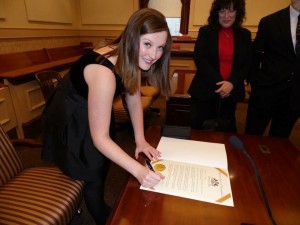 Katie Kennedy is a licensed attorney in Pennsylvania, who became Associate Director of Stewardship for Lehigh University in 2014. Prior to graduating cum laude from the Appalachian School of Law in 2013, Katie obtained her BA in SoMAS’ Environmental Studies program focusing on Marine Biology. While at Stony Brook she worked as a marine mammal trainer intern at Atlantis Marine World and conducted research in Professor Gordon Taylor’s marine microbiology lab. According to Katie “Stony Brook provided me with a truly transformative experience.”
Katie Kennedy is a licensed attorney in Pennsylvania, who became Associate Director of Stewardship for Lehigh University in 2014. Prior to graduating cum laude from the Appalachian School of Law in 2013, Katie obtained her BA in SoMAS’ Environmental Studies program focusing on Marine Biology. While at Stony Brook she worked as a marine mammal trainer intern at Atlantis Marine World and conducted research in Professor Gordon Taylor’s marine microbiology lab. According to Katie “Stony Brook provided me with a truly transformative experience.”
Katie admits that while she’s not in a traditional career associated with marine science, as an attorney, she uses many transferable skills she developed at SoMAS. “I learned to think critically. I also learned how to digest vast amounts of information and turn that information into something worthwhile. I also learned how to apply myself and rise above grand challenges. SoMAS taught me that I had a lot of grit. I am an attorney who is working for an institution of higher education and I use those critical thinking skills in many other rewarding ways!”
Katie’s advice for current students in SoMAS are to meet with your professors outside of class, find a good physical space for studying, conduct research that you are passionate about and take advantage of the SoMAS advisers expertise.
Tom Di Liberto (MS, 2009)
Tom Di Liberto grew up on Long Island and has been fascinated by the weather since he was a young child. At SoMAS, Tom studied under professor Brian Colle of the Institute for Terrerstrial and Planetary Atmospheres (ITPA) and worked with the School’s Storm Surge Research Group. His thesis dealt with storm surges affecting the New York metropolitan region. After earning his Masters degree in Atmospheric Science/Meteorology in 2009, he joined the Climate Prediction Center of the National Oceanic and Atmospheric Administration (NOAA), where he works as a meteorologist forecasting the weather for Africa, Central America, Hispaniola, and Central Asia with a focus on weather hazards that could affect food security. In addition, Tom conducts research on the use of satellite-derived rainfall estimates in these regions. His research group’s studies took on a whole new level of importance during the past year due to Super Storm Sandy. In 2013, Tom won the “America’s Science Idol” competition.
The “America’s Science Idol” competition was sponsored by the National Science Foundation’s Office of Legislative and Public Affairs, Discover Magazine,Popular Science and the Point of Inquiry Podcast. Patterned a bit after “American Idol”, the fun and engaging workshop was designed to help scientists and engineers communicate with non-technical colleagues and audiences. In winning, Tom brought home some nice loot, viz.: 1-year subscriptions to Discover and Popular Science; a live guest appearance on the Point of Inquiry podcast and the Discover DVD, as well as a variety of opportunities to visit and link with science communication groups around the country.
Helen Cheng (BS, 2009)
 Helen Cheng was the first recipient of the Stony Brook Mote Marine Laboratory Internship. She graduated with a B.S. in Biology and a minor in Marine Sciences in 2009. She is now at the Science and Resilience Institute at Jamaica Bay (SRIJB). A recent spotlight highlighted her background
Helen Cheng was the first recipient of the Stony Brook Mote Marine Laboratory Internship. She graduated with a B.S. in Biology and a minor in Marine Sciences in 2009. She is now at the Science and Resilience Institute at Jamaica Bay (SRIJB). A recent spotlight highlighted her background
From Spotlight on Helen Cheng at the Science and Resilience Institute at Jamaica Bay
The Science and Resilience Institute at Jamaica Bay (SRIJB) and New York Sea Grant are happy to announce the arrival of Helen Cheng as the Specialist for the New York Sea Grant’s Jamaica Bay Coastal Resilience. Helen will be designing outreach programs to support community engagement and research efforts to enhance resilience for the communities within the Jamaica Bay Watershed.
“Urban areas are getting more attention, especially since the devastation caused by Superstorm Sandy,” Cheng said. “Resilience is a priority across the national network of Sea Grant programs, and Jamaica Bay is internationally important setting for the issue.”
Cheng comes to SRJIB from a yearlong stint as a John D. Knauss 2015 Marine Policy Fellow at the National Oceanic and Atmospheric Administration (NOAA) Sea Grant, a highly competitive fellowship program among the nation’s highest qualified graduate students. She was the Coastal Communities Specialist working in the National Sea Grant Office in Silver Spring, Maryland, where she synthesized Sea Grant Network research and extension activities surrounding coastal community sustainable development, hazard resilience, and climate change adaptation. She was on the NOAA Coastal Hazards Resilience Workshop Planning and Support team, and assessed institutional and network research portfolios from the 33 programs of the Sea Grant Network to help identify priorities of the National Sea Grant College Program.
Helen was selected a Knauss Fellow from the New Hampshire Sea Grant program. At the University of New Hampshire she earned her M.S. in Zoology with her research on horseshoe crabs. In New England, she also worked with lobsters and scallops, was a UNH teaching assistant, and a naturalist at the nearby Seacoast Science Center. Helen earned her B.S. in Biology from Stony Brook University in 2009 where she was selected for the first-ever Stony Brook Mote Marine Laboratory internship.
David Novak (PhD, 2009)
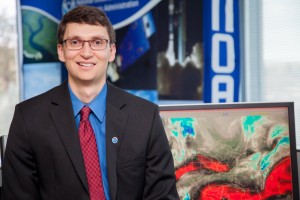 David Novak is the Director of the National Weather Service’s Weather Prediction Center in College Park, Maryland where he oversees national forecasts for heavy rainfall, snowfall, and hazardous weather. He received a PhD from SoMAS where his research involved numerical models to understand hazardous weather conditions and predict their occurrence.
David Novak is the Director of the National Weather Service’s Weather Prediction Center in College Park, Maryland where he oversees national forecasts for heavy rainfall, snowfall, and hazardous weather. He received a PhD from SoMAS where his research involved numerical models to understand hazardous weather conditions and predict their occurrence.
David’s interest in weather has been life-long. “Growing up in the extremes of Minnesota, I’ve been fascinated with the weather, and in particular, snowstorms.” His dissertation work was an extension of this passion, where he studied localized heavy snowfall events, also known as mesoscale snowbands.
According to David, while at SoMAS he “learned to consider alternative viewpoints. Marine scientists, climate scientists, and meteorologists may think differently, but sharing those diverse views leads to a better solution. Appreciating and leveraging the diversity of viewpoints is critical to my job today.”
David was pushed to “think even bigger, work even harder, and achieve even more” at SOMAS. His advice for students is to seize opportunities that take us out the our comfort zones and expand our thinking.
David has developed a fulfilling career that combines his interests in hazardous weather, his passion for helping others and applies the technical skills he developed at Stony Brook University. “I love being at the heart of the nation’s weather forecasting service and science. Whether it be an accurate forecast of a hurricane, winter storm, flood, or heat wave, I know the information we provide every day really does matter to people’s lives. I love being at the center of these advances, and in a position to influence the direction of our service, while at the same time learning from the best talent in the nation.”
Lynn Abramson (PhD, 2007)
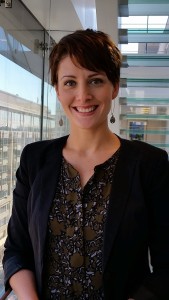 Lynn Abramson has a forged a career path that began in marine science and now influences environmental policy on a national level. She was a Ph.D student at SoMAS from 2001 to 2007 working with Bob Aller and Cindy Lee on the biological carbon pump and related biogeochemical processes. Her dissertation focused on how mineral interactions influenced the decomposition of sinking particulate organic matter, using pigments and amino acids as tracers. She recalls knowing early in her time at SoMAS, that she wanted to apply her scientific knowledge in a way that could benefit others.
Lynn Abramson has a forged a career path that began in marine science and now influences environmental policy on a national level. She was a Ph.D student at SoMAS from 2001 to 2007 working with Bob Aller and Cindy Lee on the biological carbon pump and related biogeochemical processes. Her dissertation focused on how mineral interactions influenced the decomposition of sinking particulate organic matter, using pigments and amino acids as tracers. She recalls knowing early in her time at SoMAS, that she wanted to apply her scientific knowledge in a way that could benefit others.
Upon graduation, Lynn received the prestigious John Knauss Marine Policy Fellowship sponsored by the National Oceanic and Atmospheric Administration’s Sea Grant program. Her one year fellowship morphed into more than five years of work on oceans, public lands, water resources, energy, and transportation issues when she joined the staff of U.S. Senator Barbara Boxer (D-CA). After leaving Senator Boxer’s staff Lynn joined the Clean Energy Initiative with The Pew Charitable Trusts where she coordinates their Clean Energy Business Network, that informs and engages over 3,000 clean energy business leaders. At this non-profit, non-partisan organization, she currently conducts research and works on “federal policies to promote cleaner and more efficient sources of energy.
Lynn applies her scientific understanding of complex environmental problems to practical solutions that can be implemented by businesses across the nation. According to Lynn “having a strong foundation in science has given me a much deeper, more holistic understanding of the environmental issues I’ve worked on in my policy career. My Ph.D. work trained me in objective thinking—keeping an open mind and weighing conflicting information and perspectives before making a decision.” Lynn is an excellent example of how a rigorous education in the sciences can be applied to a career in environmental policy.
Lynn has some advice for current students looking towards their future careers. “Try to learn about the diverse range of work being done by the faculty and students there. Take advantage of courses in other departments and opportunities to get involved in your broader community.” She also reminds us that “communication is key to success-in graduate school and later in your career.”
Hudson Roditi (PhD, 2000)
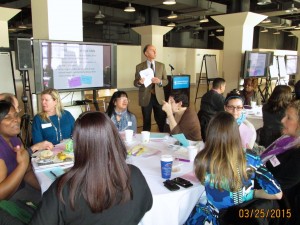 Hudson Roditi received a Ph.D from SoMAS in Coastal Oceanography in 2000, working in Nick Fisher’s lab. His thesis was titled “Rates and routes of trace element uptake in zebra mussels.” The zebra mussel is an exotic invasive freshwater species that was introduced into the Great Lakes accidentally in the mid-1980’s and has since invaded freshwaters in much of North America.
Hudson Roditi received a Ph.D from SoMAS in Coastal Oceanography in 2000, working in Nick Fisher’s lab. His thesis was titled “Rates and routes of trace element uptake in zebra mussels.” The zebra mussel is an exotic invasive freshwater species that was introduced into the Great Lakes accidentally in the mid-1980’s and has since invaded freshwaters in much of North America.
Hudson is the program director of the Urban Advantage Middle School Science Initiative at the American Museum of Natural History in NYC. He now works with over 220 schools, 640 teachers and over 60,000 students at the American Museum of Natural History, the Bronx Zoo, Brooklyn Botanic Garden, New York Aquarium, New York Botanical Garden, New York Hall of Science, Queens Botanical Garden and the Staten Island Zoo. He helps teachers learn how to shift their perceptions of science away from being memorization of facts and more towards a way of explaining the world and gaining new knowledge.
Hudson recalls, “the quality of teaching was strong at Stony Brook, and the range of oceanographic and resource management topics taught there prepared me in fields that varied from straight research to risk assessment, fisheries management, and a broad range of other topics.”
Hudson hasn’t worked in a lab since graduating from Stony Brook, but SoMAS has helped him navigate fluently through a variety of science education programs. He was the Latin American and Caribbean Regional Director for The Global Learning and Observations to Benefit the Environment (GLOBE) program, which is a worldwide science and education program funded by the National Science Foundation
According to Hudson, his success was due in part to his advisers who were “supportive of my choice to explore and find the right path for myself after SoMAS.” He encourages other students to do the same by finding their place at Stony Brook University.
Lisa Clough (PhD, 1993)
Lisa Clough, who received her Ph.D. in Coastal Oceanography from the Marine Sciences Research Center at Stony Brook University in 1993, was one of the first graduate alumni to be featured on our website. Her thesis, conducted under the direction of Professor Glenn Lopez was titled “Digestibility of Ice Algae and Phytoplankton: The Potential Impacts of Changing Food Supply to the Arctic Benthos.” She continued her work on the Arctic while a faculty member at East Carolina University
In 2015 Lisa was was named Head of the Ocean Section Division of Ocean Sciences at the National Science Foundation (NSF). Before this prestigious assignment, Lisa served as the Program Director for Antarctic Integrated System Science in the Division of Polar Programs at NSF. Lisa has served as chair of the UNOLS Arctic Icebreaking Coordinating Committee, and is the recipient of both the Arctic and Antarctic Service Medals, and the Distinguished Public Service Award from the U.S. Coast Guard. Prior to joining NSF Lisa was a faculty member at East Carolina University, also serving as the Associate Vice Chancellor for Research.
“The degree of collaboration between faculty, and the level of respect and camaraderie afforded graduate students by the faculty is what made my project possible, and what makes the MSRC environment truly unique. Since leaving MSRC, I’ve become an actual seagoing oceanographer, and I appreciate my multidisciplinary training all the more. My journeys have taken me to the Arctic Ocean four times in the last six years.
Because graduate students are encouraged to do things like give the informal Friday afternoon seminar, I felt very well prepared to present my ideas to colleagues, and to face the challenges of teaching at the college level. My training at the MSRC, and the support network that is in place among and between graduate students, faculty, and staff has allowed me to wind up in a job that I truly enjoy going to (almost) every morning!”
Sanjay Gupta (MS, 1992)
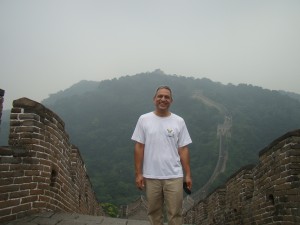 In 1992, Sanjay Gupta obtained his MS degree from Stony Brook in Marine Environmental Science, which he describes as “an excellent research and academic environment consisting of dedicated faculty and great facilities.” His focus was in physical oceanography with a thesis project developing numerical models that coupled biological and physical processes associated with the lifecycle of estuarine copepods, taking into account the impacts of climate change and how they could affect fisheries.
In 1992, Sanjay Gupta obtained his MS degree from Stony Brook in Marine Environmental Science, which he describes as “an excellent research and academic environment consisting of dedicated faculty and great facilities.” His focus was in physical oceanography with a thesis project developing numerical models that coupled biological and physical processes associated with the lifecycle of estuarine copepods, taking into account the impacts of climate change and how they could affect fisheries.
Currently an Independent Consultant in policy advocacy, water resources management, and international cooperation in South Asia, Sanjay’s clients include the World Bank, the International Union for Conservation of Nature, the United Kingdom’s Department of International Development, and Save the Children-Finland. According to Sanjay, “I get to work with local communities as well with senior-most policymakers working towards poverty reduction and enhancing prosperity.”
Sanjay says that SoMAS helped prepare him for his career three significant ways. He gained confidence in problem solving, gained a thorough understanding of estuarine dynamics that directly relates to water resource issues, and learned the utility of problem solving through multi-disciplinary teamwork. “SoMAS builds you into a multi-disciplinary professional with the requisite skills and confidence to solve real-life problems. SoMAS enables you to be innovative and think differently, to pursue careers that you cannot conceive of while studying but which you will come across as a professional.”
Hans Dam (PhD, 1989)
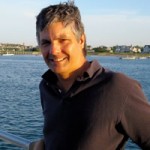 Hans Dam attended SoMAS, known as the Marine Science Research Center (MSRC) at the time, for both his Master’s and Doctoral degrees. After graduating from the University of Washington as an undergraduate in 1982, Hans came to Stony Brook to work with Dr. William Peterson. He received his MS in 1985, but stayed to work on his PhD with Dr. Peterson, finishing in 1989. During his time at the MSRC, Hans studied patterns of copepod abundance and grazing in Long Island Sound.
Hans Dam attended SoMAS, known as the Marine Science Research Center (MSRC) at the time, for both his Master’s and Doctoral degrees. After graduating from the University of Washington as an undergraduate in 1982, Hans came to Stony Brook to work with Dr. William Peterson. He received his MS in 1985, but stayed to work on his PhD with Dr. Peterson, finishing in 1989. During his time at the MSRC, Hans studied patterns of copepod abundance and grazing in Long Island Sound.
After leaving SoMAS, Hans spent a year as a post-doc at the University of Maryland’s Horn Point Laboratory. He was hired as an assistant professor at the University of Connecticut in 1991 in both the Department of Marine Sciences and the Department of Ecology and Evolutionary Biology. He has been at UConn ever since, and is currently the Acting Head of the Department of Marine Sciences and the Acting Director of the Marine Science and Technology Center.
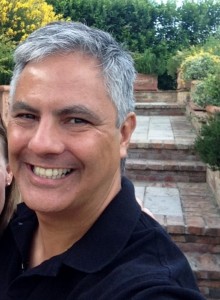 Hans’s research interests include plankton ecology and evolution, the role of zooplankton in biogeochemical cycling and fluxes of organic matter. Much of his current research focuses on plankton communities in Long Island Sound, including monitoring zooplankton populations and examining how they can control harmful algal blooms and how they respond to projected changes in temperature in the Sound associated with climate change. Hans also investigates harmful algae such as Alexandrium and how grazers respond to these blooms. He is in charge of the process studies of LISICOS, the Long Island Sound Integrated Coastal Observing System (http://lisicos.uconn.edu/). Several faculty at UCONN are conducting studies dealing with the control of hypoxia in the Sound. The contribution of Hans’ group to LISICOS is the study of downward fluxes of organic matter and grazing in elemental cycling in the Sound.
Hans’s research interests include plankton ecology and evolution, the role of zooplankton in biogeochemical cycling and fluxes of organic matter. Much of his current research focuses on plankton communities in Long Island Sound, including monitoring zooplankton populations and examining how they can control harmful algal blooms and how they respond to projected changes in temperature in the Sound associated with climate change. Hans also investigates harmful algae such as Alexandrium and how grazers respond to these blooms. He is in charge of the process studies of LISICOS, the Long Island Sound Integrated Coastal Observing System (http://lisicos.uconn.edu/). Several faculty at UCONN are conducting studies dealing with the control of hypoxia in the Sound. The contribution of Hans’ group to LISICOS is the study of downward fluxes of organic matter and grazing in elemental cycling in the Sound.
Hans reflects on his time studying marine sciences at Stony Brook: “At the risk of sounding corny, I am happy to say that my time at MSRC was one of the happiest ones. First, I had great teachers and mentors who helped me become a professional researcher, treated me with respect, and were extraordinarily generous with their time and their encouragement. Second, I also had great mates in my fellow students, some of whom have become life-long friends and colleagues. A great deal of what I am today, I owe to my years at MSRC.”
Gene Carl Feldman (MS, 1983; PhD, 1985)
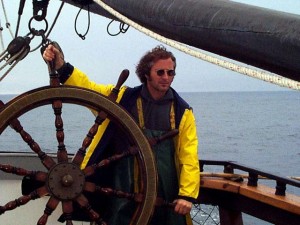 Gene Carl Feldman is an oceanographer at NASA/Goddard Space Flight Center. Currently, he is the project manager of the mission called SeaWiFS (Sea-Viewing Wide Field Sensor). Prior to his work with SeaWiFS, Gene worked with the Nimbus-7 Coastal Zone Color Scanner project.
Gene Carl Feldman is an oceanographer at NASA/Goddard Space Flight Center. Currently, he is the project manager of the mission called SeaWiFS (Sea-Viewing Wide Field Sensor). Prior to his work with SeaWiFS, Gene worked with the Nimbus-7 Coastal Zone Color Scanner project.
Gene has contributed to many additional programs, including the Joint Global Ocean Flux Study, Coastal Rhythms Exhibition at the New England Aquarium and the Jason Project. He has participated in several JASON expeditions including the JASON VII expedition when he explored the depths of the sea on board a United States Naval nuclear research submarine.
After earning a bachelor’s degree in biology at Stony Brook University, he spent three years as a Peace Corps volunteer in Western Samoa. Gene worked for the National Marine Fisheries Service and New York Sea Grant before returning to Stony Brook. Gene received his master’s degree (1983) in marine environmental sciences and his Ph.D. (1985) in coastal oceanography from the Marine Sciences Center at Stony Brook University. His doctoral research focused on satellite observations of phytoplankton variability in the eastern equatorial Pacific.
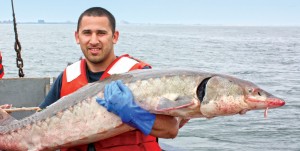
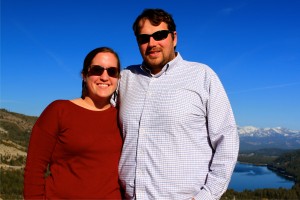
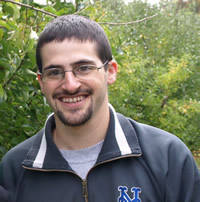

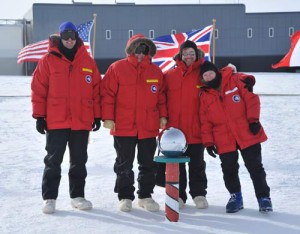
You must be logged in to post a comment.